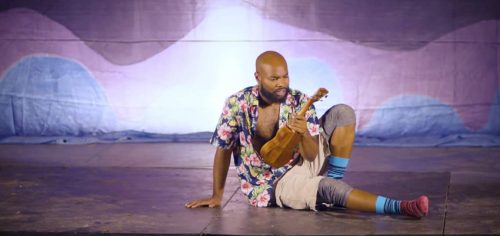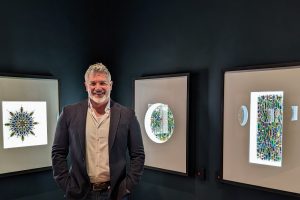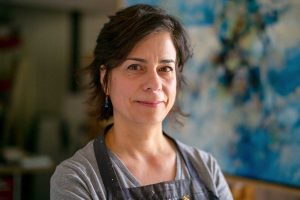Austin Ashford’s (I)sland (T)rap was a magical modern Odyssey

Austin Ashford, creator of the one-man show, (I)sland T(rap), performed at Crystal Bridges Museum of American Art on Feb. 1 to introduce Black History Month. The performance is described as a “hip-hop riff about Black Ulysses on an Odyssey of self-discovery” and was developed in Arkansas.
Ashford’s performance addressed a multitude of issues regarding his experiences as a black artist and his journey to self-discovery through performance art. Ashford played himself, exploring a magical island on a quest to reach the top of the mountain and find his own island— himself. His tale was filled with his unique twist on the classic Homer characters from Calypso to Polyphemus.
Part of what made Ashford’s version of the classic Homer tale different from the original was his approach to storytelling. Ashford relayed his story through spoken word, songs played on a ukulele, and intermittent sections of rap. His rap sections concentrated on Ashford’s inner thoughts and fears using both fictional and real experiences. He spoke about police gun violence, the meaning of Blackness, and that no one is ever alone.
Ashford said the reason why his adaptation featured himself, a black man, is because he saw a lack of black characters in the classics.
“I didn’t see black characters in historical or classical text, and if I did, it was in slavery or servitude; I knew there was more value than that,” Ashford said, “I know that I’m a black man in this world, and I’m trying to find a way to lesson the distance between my body and this world.”
Ashford said he believes storytelling is an equalizer that allows the audience to experience a world that isn’t their own. He feels storytelling is a useful tool in that it allows for the audience to get close enough to an issue for conversations to open up that couldn’t happen before.
“I call myself a storyteller because I have difficulty saying I’m a rapper, I’m a ukulelist, I’m a singer,” Ashford said, “storytelling really allows me to do all the things that I love and find my narrative. Essentially, I want to be a motivator,” Ashford said.
Ashford said an element to his performance involves the cultural belief that black men and men in general aren’t allowed to cry. He believes that men should be able to express their emotion and is able to do so through performing.
“If you want to write a good song, tell something that you don’t want other people to know about you,” Ashford said, “If you want to write a great song, write about something you’re scared to know about yourself—I’m just trying to chase greatness.”
Ashford said the most important part of any story is composed of two things: the forces and the moment one force wins.
“The moment when one force wins and how everybody else deals with it is the most important part of the story to me. The good side doesn’t always win; sometimes the bad side wins and everybody else has to deal with it.”
Ashford said another important element is the transformation that happens between the beginning and end of the story. A character must grow and have a full transformation that represents the journey they faced.
Ashford said his favorite song from (I)sland T(rap) is “Hero.” He emphasized the importance of knowing that sometimes we must be our own superheros and tap into the energy and strength within ourselves.
“I’m not saying it’s easy—it’s hard! The reason it’s called being a hero is because there are villains,” Ashford said, “But the idea that we have strength that we have not tapped into is a beautiful thing, and a lot of times we don’t know we have that strength until we’re forced to tap into it.”





Comments